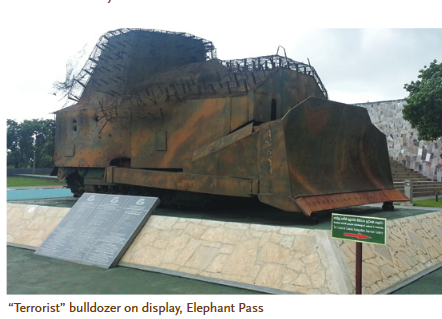ERASING THE EELAM VICTORY Part 18C Pt 1
Posted on December 11th, 2020
KAMALIKA PIERIS
War monuments are to be found in most countries. They are highly respected monuments (with the exception of Nazi Germany) and several are tourist attractions as well. Here are three war monuments from the west. They all commemorate World War II.
First is Motherland Calls” commemorating the Battle of Stalingrad in WW II. It is located in Stalingrad now Volgograd. It is twice as large as Christ the Redeemer and two meters shorter than The Statue of Liberty. The Battle of Stalingrad was a decisive battle and deserves a monument. The defeat of Nazi Germany started there.

The second is the Iwo Jima Monument in USA. it features the six servicemen who raised the U.S. flag during the Battle of Iwo Jima in 1945.The statue symbolizes the American war effort in the Pacific and is dedicated to the United States Marine Corps who died in the defense of the U.S. since 1775.

The third is the Donbass Liberators” located in Donetsk, Russia, dedicated to all who liberated Donbas during World War II. This too was a decisive battle in WWII. The monument is in the shape of a triangle with a sculpture of a Miner and a Soldier who each grasp a sword, with its edge down, in their right hands. Veterans march to the monument on Memorial Day.

Sri Lanka also has a huge WW II monument, a cenotaph, in Colombo taking up an enormous amount of valuable real estate at the end of Vihara Maha Devi Park. It is dedicated to the Ceylonese killed in the two World Wars.
The Eelam war was Sri Lanka’s first post- Independence civil war. It was a protracted war conducted by a bogus ethnic group, created by the British administration, now claiming exclusive rights to valuable coastal territory.
The government of Sri Lanka was a formidable enemy, not only militarily, but legally too. Sri Lanka, real name Sinhaladvipa, is a recognized sovereign state with clear boundaries, a seat in the UN and a well documented history. The government of Sri Lanka could not be shaken easily. It fought back and won the war. It was a decisive win. The LTTE formally declared defeat.
The government of Sri Lanka thereafter, rightly celebrated the Eelam victory over the LTTE, by erecting victory monuments. These were placed in selected locations which marked decisive battles, Kilinochchi, Elephant Pass, Puthudukuriyuppu and Kokavil. The Hasalaka Gamini monument symbolized the numerous acts of individual bravery of the Sri Lanka soldier. A military bulldozer and a water tank symbolized other aspects of the War.

State memorial, Kilinochchi
The monument at Kilinochchi, former LTTE stronghold and capital in the last years of Tamil Eelam, consists of a black-granite cuboid penetrated by a projectile that blossoms into a lotus flower. The massive cracked concrete cube represents the LTTE’s violent insurrection. The bullet piercing the stone is the Sri Lankan army, the flower represents peace.
the inscription said, ‘the gallant operation to annihilate savage and brutal terrorism which has marked this land over thirty years is marked by a cuboid and the projectile which is penetrated this cuboid symbolizing the sturdiness of invincible Sri Lanka Army to blossom forth in a lotus of peace enwrapped in the fluttering national flag that proclaims the resplendent majesty of the nation’s glory’

State victory memorial, Puthukkudiyiruppu
The Victory Monument at Puthumathalan rises from the lake at Puthukudiyiruppu. It depicts a soldier brandishing a rifle in one hand and the Sri Lankan flag in the other, with a dove seated n the gun. Around the base of the monument are four carved stone lions representing each army division involved in the last phase of the fighting, the 59th, 58th, 57th and 53rd divisions.
A stone plinth lists the names of all the army commanders at the time of the conquest. Unveiled by President Rajapaksa in December 2009 the statue defines the essentials of a Sri Lankan soldier, a brave warrior, a patriot, and the one who brought peace to the war-torn North. There is also an army war museum and a photograph gallery.

State memorial, Elephant Pass
The memorial at Elephant Pass designed by the National Design Center [1] consists of large bronze hands hold aloft a model of the island of Sri Lanka with a flower blooming atop and four lions around it.

The new memorial to ‘Hasalaka Gamini’,
Also at Elephant Pass, is the towering statue of Corporal Gamini Kularatne of the Sri Lankan Army. Now known as the Hasalaka Weeraya, Kularatne was a 25-year-old soldier who sacrificed his life in 1991 to rescue hundreds of fellow soldiers who were under siege at the Elephant Pass Sri Lankan Army garrison. He climbed into an LTTE tank and disabled it by throwing two grenades into it.


Kokavil War Heroes monument.
In February 2011, a special war hero memorial was unveiled in Kokavil, in the former LTTE Tiger heartland of Mullaitivu.

National War Memorial, Battaramulla
This is the
main war memorial at Battaramulla in front of Parliament. There are other monuments too. On the
Mullaitivu beach a monument has been set up in memory of the Special Forces
with Col. Lafir’s and Lt. Ranasinghe’s names on the top. Sri Lanka Armored
Corp opened a war memorial at
Kalaththawe in Anuradhapura. (Continued)
[1] https://www.oaklandinstitute.org/sites/oaklandinstitute.org/files/OI_The_Long_Shadow_of_War_0.pdf